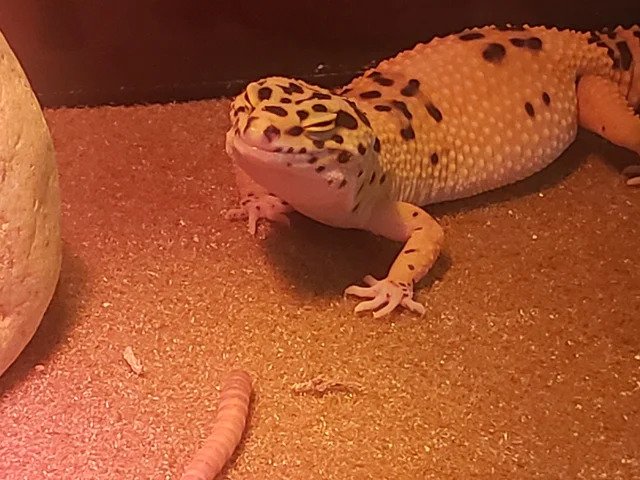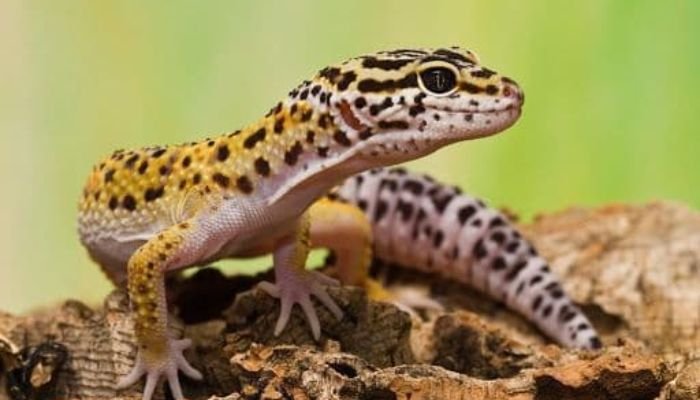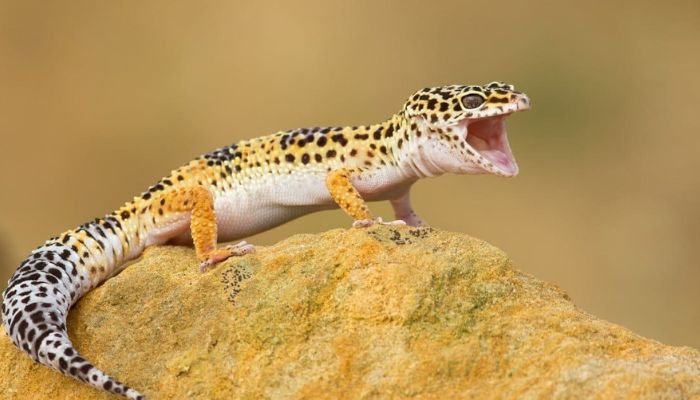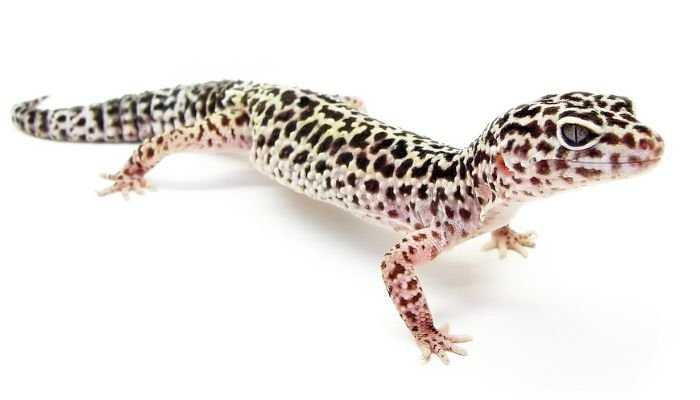
The popular and widely maintained leopard gecko is a desert-dwelling lizard native to Afghanistan, Pakistan, and India. It derives its name from the leopard-like blotches and patterns that adorn its fur. Leopard geckos are nocturnal, terrestrial creatures that prefer stony and arid environments. They are renowned for their docility, casual disposition, and unique characteristics, including the ability to vocalize and shed their tail as a form of defense. Leopard geckos are insectivorous and popular pets among reptile enthusiasts.. Here are Leopard gecko Guide on Food, Habitat, Size, Lifespan & Predators below-
Leopard Gecko Stats in Table format
The stats are given below for Leopard gecko
| Reptiles List | Leopard gecko |
|---|---|
| Family | Eublepharidae |
| Type | Lizard |
| Size | Small to Medium |
| Length | Leopard gecko: Up to 8-10 inches (20-25 cm) |
| Color | Leopard gecko: The color varies depending on the morph, but leopard geckos can have a wide range of colors and patterns, including shades of yellow, orange, or brown with dark spots or bands. |
| Weight | Leopard gecko: Adult leopard geckos can weigh between 50 to 70 grams.. |
| Lifespan | 10-20 years (or more) |
| Reproduction | Oviparous, lays eggs |
| Gestation Periods | 45-60 days |
| Endangered Status | Least Concern (IUCN Red List) |
| Features | Spotted pattern, ability to vocalize |
| Country & Areas | Native to Afghanistan, Pakistan, and parts of India, but also found in pet stores and homes worldwide. |
Leopard Gecko Natural Habitat and Distribution
Eublepharis macularius, or leopard geckos, can be found in the mountains of Afghanistan, Pakistan, India, Iran, and Nepal.They like rocky environments with nooks to hide in, as well as arid and semi-arid regions with limited vegetation and clay or sandy soils1.They could even exist in dry forests, taking cover behind flaky tree bark2.
They are primarily nocturnal, emerging from hiding at dusk when conditions are right. To escape the sun and predators, they burrow underground during the day. They are able to survive the winter by entering a semi-hibernation stage termed brumation and subsisting on fat reserves instead of food.
Leopard Gecko Physical Features and Adaptations
Here are some information about Leopard Gecko:-
Body Structure
Leopard geckos are lizards that live on the ground and are unable to climb walls because they lack the adhesive toe pads found on other geckos. Rare among geckos, they actually have eyelids. Their bodies are spherical, and they have big heads, short legs, and long tails. The usual length of a hatchling is between 7 and 10 cm (2.8 and 3.9 in), and its normal weight is between 2 and 5 grams. The maximum length for an adult is 20–25 cm (10–10 in), and their maximum weight is 100 g.
Coloration and Patterns
Leopard geckos are so named because of the spots that occur naturally on their skin, making them nearly invisible in their native habitat. They feature black dots or specks on a yellow or white background. Some examples could even be orange or pink. However, various morphs or varieties of leopard geckos with distinctive colors and patterns have emerged as a result of intensive captive breeding. Albinos, blizzards, carrot tails, eclipses, enigmas, jungles, lavenders, mack snows, marble eyes, patternless raptors, tangerines, trempers, and many more are just some of the common morphs.

Defense Mechanisms
Leopard geckos have a number of defense mechanisms at their disposal. its tail, which serves as a weapon, a means of communication, and an energy and water reservoir, is one of its primary defenses. They communicate by waving their tail, either slowly or quickly, depending on their disposition or intent. If they are feeling threatened and are prepared to attack, a gradual tail wave indicates this, while a quick tail rattle indicates excitement over food or mating.
They also have the capacity to drop their tail if they are seized by a predator, which is another protective strategy. Self-amputation, also known as autotomy. The gecko’s tail will come loose from its body and twitch for a bit, distracting the predator while the gecko makes its getaway. The tail will grow back, although it might not have the same shape.
When threatened, a leopard gecko can utilize its sharp fangs and claws to bite or scratch. However, unless provoked or abused, they are normally gentle and will not bite humans.
Leopard Gecko Diet and Feeding Habits
Here are some information about Leopard Gecko Diet:-
Diet Type
Insects make up the bulk of a leopard gecko’s diet, as befits its status as an insectivore. Their excellent sense of smell and vision aids them in tracking down and capturing their prey. After a meal, they use their tongue to lick the food residue off of their eyes and mouth.
Preferred Food Sources
The dietary demands of leopard geckos are met by eating a wide range of insects. The diet of a leopard gecko often consists of a variety of insects, such as crickets, mealworms, waxworms, superworms, roaches, silkworms, hornworms, butterworms, phoenix worms, and locusts. For at least 24 hours before offering them to the gecko, the insects should be “gut-loaded” with healthy food such fruits, vegetables, cereals, or commercial gut-load products. This makes sure the insects provide the gecko the food they need.
For young and reproducing geckos in particular, it is suggested that calcium and vitamin supplements be dusted onto the insects before being fed to the gecko. Common health problems in leopard geckos include calcium insufficiency and metabolic bone disease, both of which are helped by this.
Feeding Schedule
The frequency of feeding your leopard gecko should vary with its age, size, and activity level. Adults only need to be fed once every two days, however hatchlings and juveniles should be fed every day. The amount of food should be sufficient to prevent them from going hungry, but not so much that they end up overweight or waste food. Feed them roughly as many insects as they can consume in 15 to 20 minutes.
At night, when they are most active and hungry, leopard geckos should be fed. Both the gecko and its owner have the option of feeding it outside of or inside of its enclosure. If you feed them in a separate container, they won’t be able to get any substrate or other debris stuck in their digestive tracts, which could lead to impaction or infection.

Some geckos, though, could get agitated out if you move them or if they learn to link the container with food. They can enjoy a more natural hunting experience and have less stress if fed in their enclosure, but they may overeat, eat too quickly, or miss insects that are hiding under the ground or decorations.
Leopard Gecko Housing and Enclosure Requirements
Here are some information about Leopard Gecko:-
Terrarium Size and Setup
Leopard geckos need at least 10 gallons of tank space, but more is better. Two or three leopard geckos can live happily in a 20-gallon long tank, but only males and females should be kept together for breeding. Do not put two males in the same space; they will hurt each other if they are housed together.
A tight-fitting lid or screen cover on the tank is essential for keeping the gecko inside and preventing unwanted visitors. In order to avoid the proliferation of mold and germs, it should have sufficient ventilation. The tank needs to be kept in a stable and peaceful spot, far from any sources of noise or heat.
There should be a warm side, a cool side, and a humid hiding in the tank. A heat source producing a temperature differential of 29 to 35 degrees Celsius (85 to 95 degrees Fahrenheit) is required on the warm side. The temperature on the chilly side should be between 21 and 27 degrees Celsius (70 and 80 degrees Fahrenheit). The humidity in the moist hide should be kept between 70 and 80 percent by constantly misting it and placing it on a moisture-retaining substrate like sphagnum moss, peat moss, vermiculite, or paper towels. The gecko stays hydrated and is able to shed its skin normally thanks to the moist hide.
Geckos need enrichment and protection, so it’s important to include some tank decorations. These can be anything from rocks to branches to plants to caves to tunnels to hammocks to ledges to bowls to toys. These things need to be reliable, secure, and simple to clean. They should also be set up such that the gecko has plenty of room to roam, climb, hide, sun itself, and sleep.
Substrate Options
The substrate is what you’ll find at the tank’s base. It improves the tank’s aesthetics while also absorbing waste and odor, controlling temperature and humidity, providing traction and comfort for the gecko’s feet, and more. However, leopard geckos have certain substrate requirements. If the gecko swallows the wrong substrate, it could become impacted or infected. The gecko’s skin and lungs may also have trouble with the roughness or dustiness of some substrates.
3. Temperature and Lighting
Because they are ectothermic, leopard geckos need to take in heat from the environment in order to maintain a comfortable internal temperature. The enclosure should be heated to between 88 and 92 degrees Fahrenheit (31 and 33 degrees Celsius) on one side and cooled to between 75 and 80 degrees Fahrenheit (24 and 27 degrees Celsius) on the other. The required temperatures can be attained with the help of ceramic heat emitters or heat pads. They do not need UVB lighting, but can benefit from a day-night cycle created by a low-wattage, full-spectrum light.
4. Humidity and Water Needs
Leopard geckos can survive in low-humidity conditions just fine. They don’t need more than 40% humidity, so aim for that. They need to have easy access to clean water in a shallow dish at all times.
Leopard Gecko Behaviour and Temperament
Here are some information about Leopard Gecko Behaviour and Temperament:-
1. Activity Levels
Leopard geckos are nocturnal, meaning they are most active after dark. They would rather relax in a cool, dark place throughout the day than brave the sun. Geckos can be seen at night by their owners as they roam the terrarium in search of prey.
2. Social Behaviour
Because of their solitary nature, leopard geckos are best kept in solo enclosures free of stress and territorial disputes. If they are housed together, especially if resources are scarce, they may become aggressive towards one another.
3. Handling and Taming
With consistent, mild handling, leopard geckos can be domesticated. It’s best to ease into interactions with them so they can get used to people. Most geckos will become accustomed to human contact after some time, but it’s important to keep in mind that others may always be more comfortable with less.
Leopard Gecko Breeding and Reproduction
Here are some information about Leopard Gecko Breeding and Reproduction:-
1. Mating and Courtship Rituals
The spring and summer seasons are prime time for Leopard gecko breeding. Male geckos will wave their tails and make mating calls in an effort to woo females. When the female is fertile, mating takes place, and a few weeks later, she lays two eggs.
2. Incubation and Hatchlings
The female will lay her eggs in a suitable, moist substrate, and then bury them. Depending on the conditions, incubation might last anywhere from 40 to 60 days. Baby geckos are territorial as soon as they hatch, so it’s best to keep them apart.
Leopard Gecko Common Health Issues and Veterinary Care
Here are some information about Leopard Gecko Common Health Issues and Veterinary Care:-
1. Respiratory Infections
Stress and a lowered resistance to disease might result from respiratory illnesses brought on by improper terrarium conditions. Some symptoms include wheezing, difficulty breathing, and runny nose. In order to treat respiratory infections, immediate veterinarian care is required.
2. Parasites
Internal and external parasites like mites and worms can cause serious health problems for leopard geckos. In order to detect and treat parasitic infestations, routine fecal tests by a vet familiar with reptiles are essential.
3. Metabolic Bone Disease
Weakened bones and deformities can arise from a lack of calcium and vitamin D3, which can cause metabolic bone disease. Preventing this problem can be aided by providing a calcium supplement and UVB illumination.

Importance of Regular Vet Check-ups
Leopard geckos need to see the vet regularly to ensure their health. The expertise of a vet who has experience with reptiles can be invaluable when making decisions about nutrition, housing, and health. The gecko’s lifespan and quality of life can be greatly enhanced by preventative treatment and early diagnosis of problems.
Conclusion
Both seasoned herpetologists and newcomers to the field of herpetology find the leopard gecko to be an utterly fascinating creature. Because of their unusual appearance, eye-catching coloring, and engaging personality, these pets are loads of fun to take care of and study. It’s crucial to have an awareness of their natural environment, food, and housing preferences.
FAQs
Q: What is the family and Type of a Leopard gecko?
A: The Leopard gecko is a species of the family Eublepharidae. The Famous Leopard gecko is a member of the family Lizard.
Q: What is the average size of a Leopard gecko?
A: The average adult Leopard gecko is Small to Medium between Leopard gecko: Up to 8-10 inches (20-25 cm).
Q: How long can a Leopard gecko grow in size in lengths?
A: Leopard gecko is Small to Medium in size and The leopard gecko is a small reptile that can grow up to 8-10 inches (20-25 cm) in length.
Q: What colors do Leopard Gecko come in?
A: Leopard geckos are known for their stunning variety of colors and patterns. Depending on their morph, these geckos can display shades of yellow, orange, or brown, adorned with captivating dark spots or bands..
Q: How big can a Leopard gecko get in weight?
A: Adult leopard geckos typically have a weight range of 50 to 70 grams.
Q: What are the special Features of a Leopard gecko?
A: Leopard gecko are Spotted pattern, ability to vocalize
Q: How long do Leopard Gecko live?
A: The usual lifespan of a Leopard gecko is Leopard geckos have an average lifespan of 10-20 years, but they can live even longer with proper care and attention.
Q: What food does the Leopard gecko eat?
A: The food and diet of a leopard gecko primarily consists of live insects such as crickets, mealworms, and waxworms. They are insectivores and do not require fruits or vegetables in their diet. It is important to provide a varied diet to ensure they receive all necessary nutrients. Calcium and vitamin supplements may also be necessary to prevent deficiencies.
Q: What is the best habitat for a Leopard gecko?
Leopard geckos thrive in terrariums that are designed to seem like their native habitat. A tight-fitting lid is necessary for retaining moisture and temperature within. To provide the gecko adequate room to roam, the terrarium’s volume should be at least 20 gallons. If you want to make cleanup a breeze, use reptile carpet or paper towels as a substrate. There should be a temperature gradient with a warmer area, approximately 90 degrees Fahrenheit, and a cooler area, around 75 degrees Fahrenheit. Calcium metabolism in the gecko is dependent on exposure to UVB rays. The gecko needs safe places to retreat to, such caverns or logs. A calcium dish and a shallow water dish are also recommended. To keep the leopard gecko happy and healthy, its enclosure needs to be cleaned and maintained on a regular basis.
Q: How do Leopard Gecko give birth?
A: Leopard gecko are Oviparous, lays eggs
Q: How long is the gestation period for a Leopard gecko?
A: The gestation period of a Leopard gecko is approximately 45-60 days
Q: What is the natural behavior of a Leopard gecko?
Most Leopard geckos fall within the Because of their nocturnal nature, leopard geckos are rarely seen during the day. They’re naturally lonely beings that just like to be left alone. They are skilled climbers and can usually be found perched high in a tree or on a nearby rock. Another well-known trait of leopard geckos is their defensive tail-shedding behavior. As insectivores, their diet consists mainly of insects like crickets and mealworms. In order to better blend in with their environment, leopard geckos are able to alter their skin tone. They talk to one another using gestures and sounds like chirping and hissing. As a group, leopard geckos are remarkable because of their unusual traits and activities.
Q: Is the Leopard gecko endangered?
A: The Leopard gecko is Least Concern (IUCN Red List).
Q: What are the prey of Leopard gecko?
Predators like leopard geckos feed mostly on insects like crickets, mealworms, and waxworms. They can spot their prey from far away and then devour it with the help of their strong fangs. There have been reports of them eating lizards and even small mammals out in the wild. However, as insects make up the bulk of their diet, these animals play a crucial role in maintaining manageable insect populations in their natural environments.
Q: Do Leopard gecko have any Predators?
Answer: A. Leopard geckos are Snakes, birds of prey, larger lizards, and small mammals like rats and mice are all potential threats to leopard geckos. Leopard geckos are a common prey item for these predators in their native environments. To protect themselves from predators, leopard geckos have evolved a number of strategies, including the capacity to drop their tail and adopt a camouflaged appearance.
Q: How Fast Does Leopard gecko Move?
A: Leopard geckos can move at speeds of up to 8 miles per hour.
Q. What is Bite Force of Leopard gecko in PSI?
A. Bite Force in PSI for a leopard gecko is not applicable as they have weak jaws and do not bite forcefully.
Q: Can we keep Leopard gecko as pets?
It is true that leopard geckos can be raised in captivity. They require little attention and are simple reptiles to care for. These reptiles are popular among pet owners because they are tame and easy to care for. In addition to their unusual appearance, leopard geckos are fascinating pets because of their varied and entertaining habits.
I hope you like reading on Leopard Gecko FAQ Guide on Food, Habitat, Size, Lifespan and Predators.
